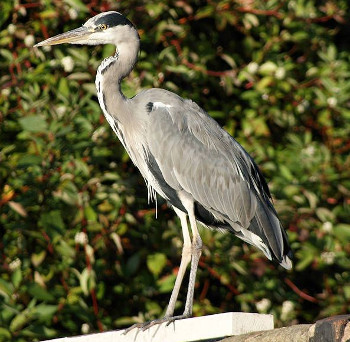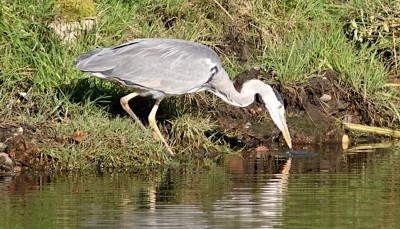I WONDER how many of you boaters out there have observed this somewhat strange behaviour by a heron, writes Ralph Freeman.
 The bird allows the bow of your boat to draw almost level and then it flies off, not to circle around behind your boat which would be the most energy efficient course of action, but instead flies 40 to 50 yards up the Cut and waits for your boat to catch up. This process may be repeated many times, presumably until the heron reaches the limit of it's territory and then it finally flies around your approaching boat. Initially, I put this down to the heron not being very bright, but later I was to realise this opinion was very wrong!
The bird allows the bow of your boat to draw almost level and then it flies off, not to circle around behind your boat which would be the most energy efficient course of action, but instead flies 40 to 50 yards up the Cut and waits for your boat to catch up. This process may be repeated many times, presumably until the heron reaches the limit of it's territory and then it finally flies around your approaching boat. Initially, I put this down to the heron not being very bright, but later I was to realise this opinion was very wrong!
The penny finally drops
It took two separate incidents on the northern/Middlewich Branch of the Shroppie to set me thinking about the strange heron behaviour regarding narrowboats. Now I already knew that herons were not particularly concerned about narrowboats on the move as I had often passed them early in the morning and they didn't bother to move at all as they were still half asleep perhaps.
In one instance however, a heron flew ahead, stopped, peered into the Cut and after a small delay struck and pulled out a catch. In quick succession it caught two fish and a frog from only five hops forward. This heron was either very lucky or up to something?
Pressure wave
I was moored not far from Church Minshall when my boat gave a violent lurch backwards and snatched hard at the mooring ropes. (Fortunately I was moored up via piling hooks not pins!). I thought someone must have 'dumped' the nearby Church Minshall lock rapidly, but then realised the lurch was in the wrong direction and too violent anyway. A full five minutes elapsed before the cause appeared.
 A hire boat from Middlewich was going like the clappers to get to the Llangollen, leaving it's wash on the towpath! It was the pressure/bow wave from this boat, possibly magnified by the boat 'punching' through a bridge hole, that had caused my boat to lurch backwards.
A hire boat from Middlewich was going like the clappers to get to the Llangollen, leaving it's wash on the towpath! It was the pressure/bow wave from this boat, possibly magnified by the boat 'punching' through a bridge hole, that had caused my boat to lurch backwards.
It then occurred to me could this be what that crafty heron, I saw a few days earlier, was using to such good effect to enhance it's chances of catching it's breakfast? By flying ahead it could be in 'fishing mode', when the small pressure wave that travels in front of a narrowboat at normal speed, passed by it? Later I watched a boat go by where part of the bank had subsided and formed a shallow patch and indeed the pressure wave as a narrowboat approached could clearly be observed. This wave was enough to disturb fish into movement, which could prove fatal if a heron was watching.
What about refraction?
If a heron is to catch it's prey with a precise, angled, strike into the Cut, it would miss if it didn't take into account refraction. This is the effect where the reflected light from, say a fish, is bent at the water/air boundary. (Google'"air/water refraction' for diagrams etc) or place a straw in a glass of water to see the effect.
The net effect of refraction is the fish would be nearer to the heron than it appeared and deeper too. So without compensating for refraction the heron would almost certainly miss!
Conclusion
Whilst it may be wrong to suggest herons 'understand' physics, for I doubt they consciously calculate the position of their target, they must compensate for refraction or go hungry. I'm pretty convinced some also use the pressure wave from approaching narrowboats to enhance their fishing technique.
The question I am left with is this. Is this learned behaviour, or is the heron's brain pre-programmed with this knowledge about physics? Either way the heron is not as dumb as I thought.
